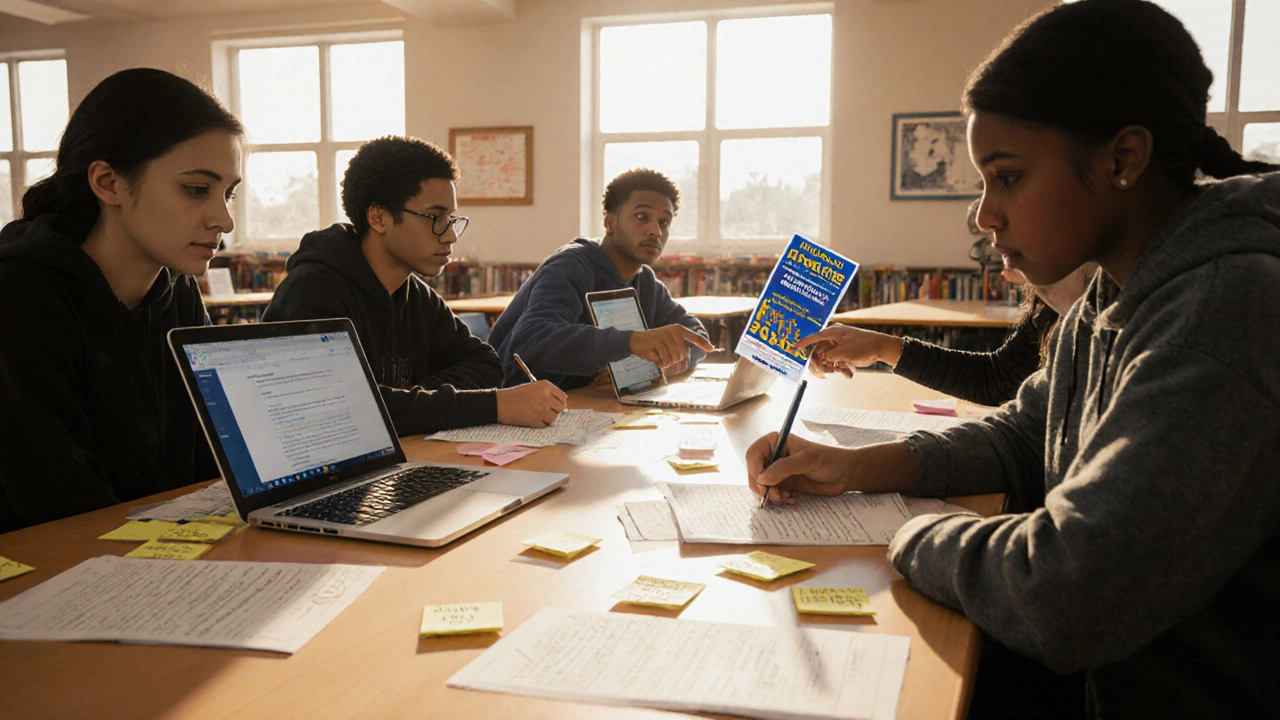Scholarship Odds Calculator
According to the article, your odds depend on your strategy. Applying to local or niche scholarships (like those for specific hobbies or backgrounds) dramatically increases your chances. The average success rates are:
- Local scholarships: 20-50% success rate
- Special interest: 30-70% success rate
- National scholarships: 0.5-2% success rate
Calculate Your Odds
Enter your application details to see your realistic success chances
Your estimated success rate:
Every year, millions of students apply for scholarships. Some get lucky. Most don’t. But here’s the truth: your odds aren’t just random. They’re shaped by choices you make before you even hit "submit".
What Are the Real Odds?
There’s no single number for scholarship odds-it depends on who you are, where you’re applying, and how you apply. But data from the National Center for Education Statistics shows that in the U.S. alone, about 1 in 8 undergraduate students receives a scholarship or grant from a private source. That’s roughly 12.5%. For international students, the rate drops to around 5-7% at top universities.
At the high school level, only about 1 in 20 students wins a merit-based scholarship worth more than $5,000. Need-based aid is more common, but it’s not always called a scholarship. Pell Grants, for example, are federal aid, not scholarships-and they go to nearly 7 million students a year, but only those with household incomes under $65,000.
So if you’re chasing a full ride to a competitive school like Harvard or Oxford? Your odds might be less than 1%. But if you’re applying to smaller, local scholarships? Your chances jump to 1 in 3 or even 1 in 2.
Why Most Applications Fail
People think scholarships are won by the smartest or the richest. That’s not true. They’re won by the most specific.
Take this real example: a student in Adelaide applied for a $2,000 scholarship from the local Rotary Club. The application asked for a 300-word essay on "How your community volunteer work changed your perspective." She wrote about helping at the Adelaide Food Bank, how she saw kids her age go hungry, and how it made her want to study nutrition. She didn’t mention her GPA. She didn’t list her awards. She told a story.
She won.
Meanwhile, hundreds of other applicants wrote generic essays: "I’m hardworking and passionate about education." Those got tossed. Why? Because they could’ve been written by anyone. The selection committee saw 200 of them. They didn’t remember any.
Most scholarship applications fail because they’re vague, impersonal, or too long. They don’t answer the question. They don’t show personality. They don’t prove impact.
How to Boost Your Odds
Here’s what actually works:
- Apply to local scholarships first. Big national awards get 10,000+ entries. A scholarship from your high school, church, or local business might get 50. Your odds jump dramatically.
- Use niche criteria. Look for scholarships tied to your hobbies, heritage, job, or even your pet’s breed. There’s a scholarship for left-handed students. One for children of firefighters. One for students who grow their own vegetables. If it’s specific, fewer people apply.
- Follow the instructions exactly. If they ask for a 500-word essay and you send 600? You’re out. If they want a PDF and you send a Word doc? You’re out. These aren’t tricks-they’re filters. They weed out careless applicants.
- Get feedback before submitting. Have a teacher, counselor, or even a friend read your essay. Ask: "Does this sound like me?" If the answer is no, rewrite it.
- Apply to every scholarship you qualify for-even small ones. A $500 scholarship might not seem like much. But if you win five of them? That’s $2,500. That’s a semester’s textbooks, or a plane ticket home for holidays.

Types of Scholarships and Their Odds
Not all scholarships are created equal. Here’s what you’re really up against:
| Scholarship Type | Typical Applicants | Estimated Win Rate | Best For |
|---|---|---|---|
| Local community (Rotary, Lions Club) | 20-100 | 20-50% | Students with strong community ties |
| High school-specific | 50-200 | 15-40% | Students with good grades or extracurriculars |
| State or government grants | 500-5,000 | 5-15% | Low-income students |
| National merit-based | 10,000-100,000+ | 0.5-2% | Top 1% of students |
| Special interest (e.g., left-handed, pet owners, farmers’ kids) | 10-100 | 30-70% | Anyone with a unique trait |
The takeaway? Don’t chase the big names. Chase the ones that fit you.
Where to Find Scholarships That Actually Work
Don’t waste time on websites that list 5,000 scholarships and require you to sign up for emails. Here’s where real opportunities hide:
- Your high school’s guidance office-most have a binder of local scholarships no one searches for online.
- Local libraries-they often have flyers for scholarships from businesses in town.
- Employers of your parents-many companies offer scholarships for employees’ children.
- Religious organizations, cultural associations, and alumni groups-these rarely advertise widely, but they give out money every year.
- Professional associations in fields you’re interested in-like the Australian Nursing Federation or the Australian Institute of Architects.
One student in Perth found a $10,000 scholarship through her dad’s plumbing union. No one else applied because they didn’t know it existed. She got it.

Common Myths That Cost Students Money
Myth: You need a 4.0 GPA to win a scholarship.
Reality: Many scholarships have a 3.0 minimum. Some don’t even ask for GPA. They care about your story.
Myth: Only rich kids get full rides.
Reality: Most full scholarships are need-based. They’re designed for students who can’t afford school.
Myth: You have to be an athlete or genius.
Reality: There are scholarships for students who bake, write poetry, fix bikes, care for siblings, or survive foster care.
Myth: You should wait until senior year to start applying.
Reality: Some scholarships open as early as Grade 9. Starting early means more chances, more practice, and less stress later.
What to Do If You Don’t Win
Rejection isn’t failure. It’s data.
If you applied and didn’t get it, ask: Did I follow the instructions? Did I tell a real story? Did I stand out? If the answer is no, adjust. If the answer is yes, keep applying. One student applied to 37 scholarships in her last year of school. She won 8. That’s $18,500.
Scholarships aren’t about luck. They’re about persistence. The people who win aren’t the most talented. They’re the ones who kept showing up.
Final Tip: Start Today
Right now, there are scholarships open with deadlines in the next 30 days. Some are worth $200. Some are worth $10,000. But they all have one thing in common: you have to apply to win.
Open your laptop. Go to your school’s scholarship page. Find one that fits you. Write one paragraph. Submit it. Then do it again tomorrow.
That’s how you beat the odds.
What are the odds of getting a full scholarship?
Full scholarships are rare-less than 1% of applicants win one at top universities. But many students get partial scholarships that add up. Combining local, state, and private awards can cover most or all costs. Focus on applying to many smaller ones rather than waiting for one big win.
Do I need perfect grades to qualify for a scholarship?
No. Many scholarships require only a 2.5 or 3.0 GPA. Others don’t look at grades at all. They focus on community service, leadership, financial need, or personal stories. Your grades help, but they’re rarely the deciding factor.
Can international students get scholarships?
Yes, but options are more limited. Most government scholarships are for citizens. However, many universities offer merit-based scholarships to international students, and some NGOs and private foundations fund global applicants. Look for scholarships specifically labeled for international students-don’t assume you’re excluded.
Are scholarship scams common?
Yes. Legitimate scholarships never ask you to pay a fee to apply. If a website asks for your credit card, bank details, or a processing fee, it’s a scam. Also avoid services that promise guaranteed wins for a fee. The only thing you should pay for is postage (if required), and even that’s rare.
When should I start applying for scholarships?
Start as early as Grade 9. Many scholarships are open to students in their final years of high school, but some begin accepting applications in Year 10 or even earlier. Starting early gives you time to build a strong portfolio of experiences and essays. Don’t wait until your final year.

